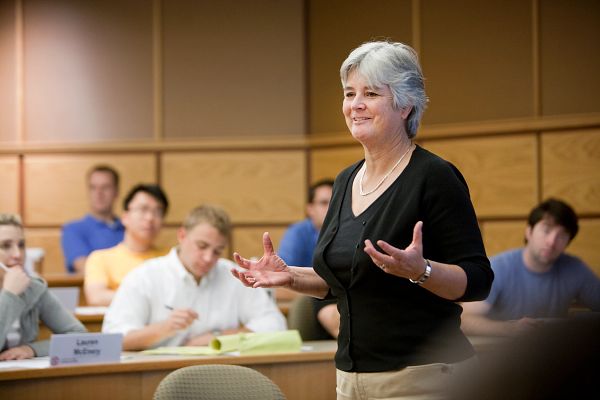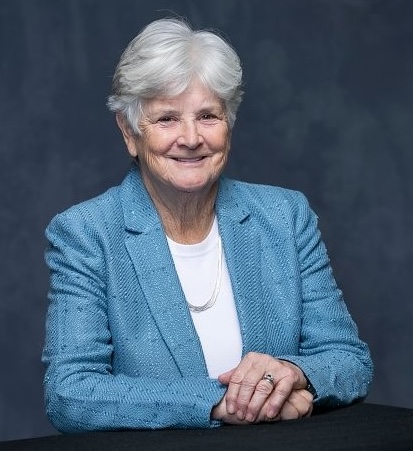Maureen O’Hara Named Quant Researcher of the Year

Professor Maureen O'Hara 's career at Cornell began in 1979.
by Donna Talarico
The Journal of Portfolio Management named Maureen O’Hara the Portfolio Management Research (PMR) Quant Researcher of the Year for 2023. O’Hara, the Robert W. Purcell Professor of Management at the Samuel Curtis Johnson Graduate School of Management, is a prolific researcher, most notably in market microstructure.
A researcher, professor, and consultant, her work exemplifies the journal’s dedication to bridging the gap between finance research and industry practice. A prime example of real-world application: as an advisor to the SEC, she played a crucial role in investigating the Flash Crash of 2010—the biggest one-day point decline in the history of the Dow Jones Industrial Average—and in the subsequent regulation changes.
O’Hara authored the classic textbook Market Microstructure Theory, and her vast body of work spans topics from EFT’s effect on market stability to experimental economics.
“It’s impossible to study modern finance without reading her work,” said Marco Lopez de Prado, a previous Quant Research of the Year, of O’Hara in a statement about the award.
Understanding Market Microstructure

Microstructures, explains O’Hara, are essentially the “design of exchanges, trading systems, that sort of thing.” She and other researchers in this area aim to understand the best way to structure and regulate these systems, such as examining the rules about how orders are processed and what information is available to people in the market.
When she began her work in the early 1980s, there was budding interest in the structure of securities markets, but the field was still relatively quiet. In a past interview with PRM’s Frank Fabozzi, she explains that all changed after the crash of 1987.
“… all of a sudden, everybody cared about microstructure,” recalls O’Hara, adding that she was initially drawn to this area of research because, like banking, exchanges and trading systems are all about rules: What rules make an exchange meet its functions of liquidity and price discovery best?
“And then, the question is, do you have the right rules, and that’s what I became interested in,” she told Fabozzi, adding that she remains endlessly fascinated by the work.
From NASDAQ’s entry into electronic trading in the ’80s to emerging technology like machine learning, microstructure has become more mainstream and plays an integral role in asset pricing.
“What’s happened over time, microstructure became just a lot more important to how markets work, and not just to the exchanges and regulators themselves, but also to the brokerage firms that handle the orders and high-frequency traders who are now such an important part of markets,” she adds.
For instance, she explains the skills active managers use to generate returns for their investors are often influenced by the work that people in microstructure research do.
“An awareness of how microstructures work can reduce your transaction’s cost of trading,” says O’Hara. “So that’s another direction in which microstructure has become very important, not just for geeks who care about exchange structure but everyone in the market.”
“Microstructure [is] not just for geeks who care about exchange structure but everyone in the market.” — Maureen O’Hara
Regulating Emerging & Evolving Assets
O’Hara is part of the interdisciplinary theme, FinTech at Cornell. FinTech is an incredibly broad term that encompasses everything from banking apps to payment processing systems. Within this vast realm, crypto—more specifically, the rules governing how it’s traded—has become a research interest for O’Hara.
She explains how crypto currency was originally developed by computer scientists to be secure, not necessarily designed with markets in mind. As crypto has gotten larger and larger, though, the same issues that have affected other assets affect crypto: what’s the right way to trade crypto, and what are some of the problems in regulating it?
“Crypto is another type of asset, just like stocks and bonds and options and foreign exchange—and all of those areas have market microstructures,” says O’Hara, adding that as an asset class, crypto is one “that’s been relatively unregulated, so it has more inefficiencies than other asset classes.”
And that’s where the market microstructure understanding comes in. O’Hara has co-authored several papers in this area, including “Innovation and Informed Trading: Evidence from Industry ETFs” and “Microstructure in the Machine Age,” both published in Review of Financial Studies in 2021.
Influencing the Future of Finance
Historically—and as the journal name would imply—many Quant Researchers of the Year honorees have been mathematicians. O’Hara says it’s an honor to be selected, and, more broadly, she’s proud that microstructure research has been recognized.
“There’s a lot of people doing a lot of great research. The nice thing about this award, to me, is that it recognizes that a lot of what will influence markets and their behavior is the structure, and the analysis of the structure—and that’s what my sort of work does. It helps those people who want to apply cutting-edge research to financial practice.”
As an educator, she’s inspiring future financial professionals to do just that, says Andrew Karolyi, the Charles Field Knight Dean of the Cornell SC Johnson College of Business.
“Maureen’s market microstructure research is invaluable in an ever-changing field, one where new technology continually introduces new rules,” says Karolyi. “Our graduate students are incredibly fortunate to learn from someone who has been so influential.”
